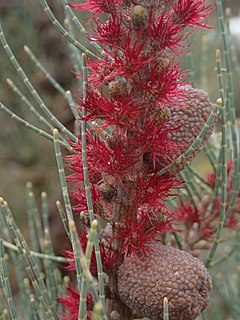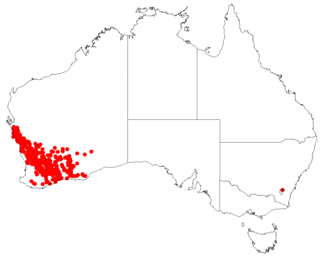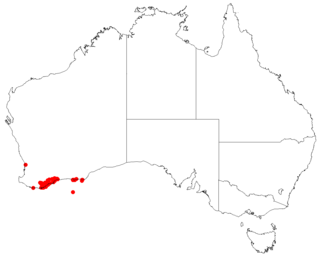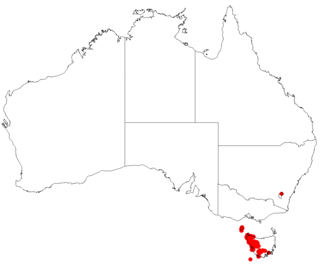
Allocasuarina is a genus of trees in the flowering plant family Casuarinaceae. They are endemic to Australia, occurring primarily in the south. Like the closely related genus Casuarina, they are commonly called sheoaks or she-oaks.

Casuarina is a genus of 17 tree species in the family Casuarinaceae, native to Australia, the Indian subcontinent, southeast Asia, islands of the western Pacific Ocean, and eastern Africa. It was once treated as the sole genus in the family, but has been split into four genera.

Allocasuarina fraseriana, commonly known as western sheoak, common sheoak, WA sheoak. Fraser's sheoak or just sheoak, is a tree in the family Casuarinaceae. Endemic to Western Australia, it occurs near the coast in the south west corner of the State, from Jurien to Albany . The Noongar peoples know the tree as Condil, Kulli or Gulli.

Allocasuarina huegeliana, commonly known as rock sheoak or sighing sheoak, is a tree in the family Casuarinaceae. Endemic to Western Australia, it occurs mostly throughout the Wheatbelt region. It is now especially common on road verges, where it sometimes forms thickets.

Allocasuarina humilis, commonly known as the dwarf sheoak or dwarf casuarina, is a woody shrub of the family Casuarinaceae endemic to the south-west of Western Australia.

Allocasuarina distyla, commonly known as scrub she-oak, is a shrub or small tree of the She-oak family Casuarinaceae endemic to New South Wales.

Allocasuarina littoralis, commonly known as black sheoak, black she-oak, or river black-oak, is an endemic medium-sized Australian tree. A. littoralis is named for its growth near the coast; this is somewhat misleading, as it will grow well both inland and in coastal zones.

Allocasuarina inophloia, also known as woolly oak, or stringybark she-oak, is a shrub or small tree of the she-oak family Casuarinaceae endemic to inland New South Wales and Queensland. The hairy bark is an unusual feature.

Allocasuarina campestris, commonly known as the Shrubby she-oak, is a shrub of the she-oak family Casuarinaceae native to Western Australia.

Allocasuarina decussata, commonly known as karri oak or karri she-oak, is a medium-sized tree, or more rarely a shrub, that is endemic to the south west of Western Australia. It is an understory tree in karri forest but also occurs as a stunted shrub in places like Bluff Knoll in the Stirling Range.

Allocasuarina acuaria is a shrub of the genus Allocasuarina native to the Wheatbelt, Goldfields-Esperance and Great Southern regions of Western Australia.

Allocasuarina acutivalvis is a shrub or tree of the genus Allocasuarina native to the Wheatbelt, Goldfields-Esperance and Mid West regions of Western Australia.

Allocasuarina eriochlamys is a shrub of the genus Allocasuarina native to the Goldfields-Esperance region of Western Australia.
Allocasuarina fibrosa, commonly known as the woolly sheoak, is a shrub of the genus Allocasuarina native to a small area in the central Wheatbelt region of Western Australia.
Allocasuarina globosa is a shrub of the genus Allocasuarina native to the Goldfields-Esperance region of Western Australia.

Allocasuarina grevilleoides is a shrub of the genus Allocasuarina native to a small area in the western Wheatbelt region of Western Australia.

Allocasuarina thuyoides, commonly known as the horned sheoak, is a shrub of the genus Allocasuarina native to a large area in the Mid West, Wheatbelt, South West and Goldfields-Esperance regions of Western Australia.

Allocasuarina trichodon is a shrub of the genus Allocasuarina native to an area along the south coast in the Great Southern and Goldfields-Esperance regions of Western Australia.

Allocasuarina zephyrea, commonly known as the western scrub sheoak, is a shrub of the genus Allocasuarina native to Tasmania.
Allocasuarina filidens, commonly known as the Mount Beerwah sheoak, is a shrub of the genus Allocasuarina native to Queensland.

















